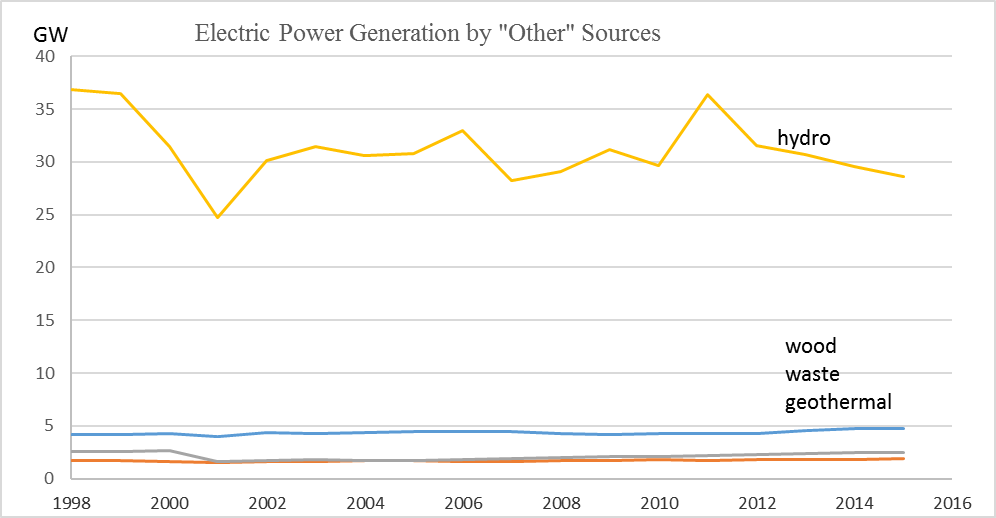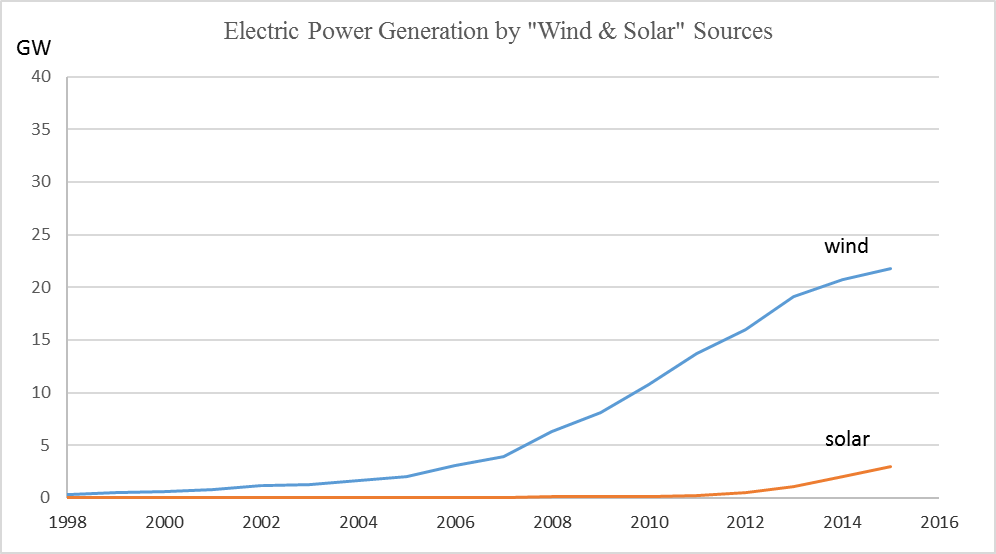Renewable Energies: The Mirage of Mass
By Stanislav Jakuba -- March 30, 2016“Wind power’s growth is challenged because the best sites for windmills have already been exploited, the end-of-life mills are being torn down, subsidies are declining, and some of the enthusiasm for windmills departed with former DOE Secretary Dr. Chu. The new Secretary, Dr. Muniz, believes in solar.”
As most people are, I too am subjected daily to the mass media reports that broadcast the need for building renewable, clean energy sources. Those sources are usually identified as “wind, solar and others” followed by a hint at their rapidly increasing output.
Suspicious, I looked up the sources and their annual output as compiled by our Department of Energy (doe.eia.gov). The result are plotted in the two attached graphs. The upper one shows the “Other” sources, the lower one “wind and solar.”
Looking at the four sources in the upper graph, hydro, wood, waste and geothermal, there has not been a worthwhile upward trend in any of them for two decades. Their combined output is lower today than it was in the decades past.
Three of the four sources provide a minuscule amount of energy in comparison to hydro. Two of the three weak ones, wood and waste, are not classified as clean sources for their burning emits CO2 along with “real” pollutants. The legitimate clean output of the three then originates only from the geothermal source. It generates 1.9 GW, unchanged in decades.
The fourth source – hydro – provides 29 GW which is 94 percent of the 30.9 GW yield from this group of clean, renewable sources. To increase hydro, it would have to either rain more or we would have to reduce irrigation (dams often serve both purposes). The rain is beyond our control and the irrigation – are we willing to cut down on fresh veggies?
It should also be pointed out that this source, as well as the other three, cannot be claimed a result of the last decades’ financing. They existed long before the clean-energy budgets existed.
The real growth originates thus from just two of the six sources: wind and solar (W&S). Their contribution is illustrated in the lower chart. When combined, W&S generated 24 GW, somewhat less than the old-timer hydro. Wind growth is shown slowing down while solar, the smaller of the two, turned linear for 2015.
Wind power’s growth is challenged because the best sites for windmills have already been exploited, the end-of-life mills are being torn down, subsidies are declining, and some of the enthusiasm for windmills departed with former DOE Secretary Dr. Chu. The new Secretary, Dr. Muniz, believes in solar.
Let’s now consider the contribution of the renewables’ combined 55 GW on the scale of the U.S. energy usage of 467 GW for electricity and 3,260 GW for primary energy in 2015. The W&S would have to produce additional 412 GW for 100 percent renewable electricity generation. Should electric cars become ubiquitous (they will not) they will consume another 110 GW lifting the total to 522 GW from the 2015 level.
De Minimus
Do renewables matter? Can wind and solar impact global climate change measurably?
Apparently not. There is also no chance that the US, or individual states, will meet the repetitious commitments for 20, 50 or 100 percent of energy to “be derived from renewable, clean sources” in the usual 5, 10 or 20 years timetable, numbers repeatedly proposed by the facts-ignorant politicians and prejudiced media in cohorts with the “Big Wind and Big Solar” interests.
The question is now how many billion dollars were spent on developing wind and solar to get the above gigawatts. Unable to find a reliable number I will, instead, in Part II compare the budget vs. output of the largest, newest, and allegedly most efficient solar plant operating in Mojave desert and compare it to another type of clean power plant.
Conclusion
Some dozen years ago, I won the best-letter-to-editor award from Hartford Courant when commenting on the then-planned goal of 20 % of Connecticut energy from clean sources by 2010. I wrote: “It will not be done.” It was not done, nor was it done with subsequent such proclamations. We can safely assume the same fate for the currently debated commitments.
I can be challenged on the last statement, because, fortunately for the politicians’ carriers, the meaning of the term “clean and green” is somewhat flexible in those circles. The above numbers, the graphs, and the proper meaning of terms should help us challenge the “green” media and the other-people-money-spending politicians.
————
Stan Jakuba has had a distinguished career in mechanical design and development in both private industry and Government, particularly with alternative-fuel engines and near-zero pollution automobiles. He has provided engineering and educational services to dozens of companies, ranging from GM and GE to small R&D firms.
Jakuba holds a B.Sc. from Ceske Vysoke Uceni Technicke (CVUT), Prague, Czech Republic, and an M.Sc. from Massachusetts Institute of Technology (MIT). He resides in West Hartford, Connecticut.


Thanks for this, and this website. As my name indicates, I have found the subject of renewable energy (wind and solar) maddening. It simply doesn’t work. At all. I’ve come at the problem every way I can think of, and the bottom line is that transforming diffuse, intermittent, weak energy sources into reliable, powerful energy sources is simply not possible.
For most power sources we are doing the opposite – taking extremely powerful sources of energy (hydrocarbons, falling water, nuclear energy) and downscaling it to my electrical socket. In such an effort, inefficiencies and loses don’t matter much. In the case of wind and solar, I’m trying to upscale the energy – take low energy solar power and make it strong enough to boil water on my stove. Entropy just doesn’t work that way.
Great article and excellent comment Frustrated Scientist. The current administration is either ignorant of these facts or is purposely trying to destabilize the grid and lower the standard of living in America.
It doesn’t work in USA, as the country is rather backwards regarding electricity supply to its population. But it does work in more advanced countries such as Denmark and major industrial country Germany, which follows Denmark with a delay of ~ a decade.
In Germany the (share of) renewable in consumed electricity between 2000 and 2015 grew greatly:
Wind from 9TWh => 88TWh
Solar from 0TWh => 38TWh
All renewable from 38TWh => 196TWh
Total consumption was in 2015; 600TWh. So renewable delivered ~32% of that.
Germany increases the share of renewable gradually towards 60% in 2030. It will continue to increase that share in the decades thereafter.
In Denmark wind delivers 40% of all electricity. Denmark expects that wind will deliver >50% of its electricity in 2020. The country targets that in 2040 renewable will produce all electricity in Denmark.
Furthermore that the country will be 100% renewable regarding all energy (incl. heating and transport) in 2050. There, new buildings are only allowed if the owner can show that the building in energy neutral…
The reliability of electricity supply in both countries is >8 times better than in USA!
Bas:
I wish you would abstain from news containing futuristic “will get,” “plans to,” etc. There is plenty of such renewables propaganda in the mass media.
Past records show that wind supplied 20 % of Denmark’s electricity of which less than half, and sometimes as little as one fifth, is consumed there. There is a difference between generated and consumed.
Most people appreciate the havoc that intermittent output of wind causes to the grid. There has to be way to compensate for it. Denmark has the option to keep its thermal power plants going steady (i.e. efficiently) because it utilizes the easy on easy off hydro-plants in Norway and elsewhere. Norway, having numerous steep rivers,, buys Denmark’s surplus electricity when the wind blows hard paying very little for it as anyone who does not need it would. On the other hand, when the wind doesn’t blow Denmark buys it at the going rate be it from France, Germany or Norway. Denmark’s electricity is the dearest among industrial nations, Norway’s among the cheapest. Undoubtedly, erecting rows upon rows of their own turbines was Denmark’s way to advertise their industry and generate revenue when it manufactured the lion’s share of the turbines in the world.
Denmark is also a country boasting of no importation of oil, a fact erroneously understood by some as being the consequence of the wind power utilization. Denmark owns and exploits enough territory (at home and in the North Sea) to cover its oil and gas needs fully. With zero fossil fuel imports (except coal – that is all imported, and most of it is burned to make electricity) Denmark is in the same position the U.S. was a century ago when it was also self-sufficient, and when its population was one quarter of the present. Today, Danes endure the highest fuel prices and, unlike the U.S., Denmark’s population exhibits a minuscule growth.
To provide the whole energy picture in Denmark, the utilized wind electricity amounts to some 1 to 2 percent of the primary energy in that country. While that is an almost negligible percentile, it is impressive nevertheless when compared to the 0.7 % in the U.S.
@Stan,
“Past records show that wind supplied 20 % of Denmark’s electricity…”
That was some years ago.
In 2015 wind supplied 40% of Denmark’s electricity!
You can be sure that it will be 50% in 2020 as there is no opposition against that increase. While in Germany ~90% of population supports the Energiewende, there is no opposing voice/movement in Denmark. That allows Denmark to move much faster than Germany with their energy transition.
Shown by measures such as, that only the construction of energy neutral buildings are allowed.
Great article.
As to getting 100% of our energy from erratic breezes, it is important to realize that the wind turbines produce precisely nothing unless there is electricity on the grid from reliable sources. The grid becomes unstable when the wind component is over about 10%.
Highly advertised high percentages of electrical energy from wind come from a trading gimmick: if (say) Minnesota produces a lot of wind energy and California is in the market for heissbeliebte wind, California “buys” Minnesota’s excess, but nevertheless gets its electricity from coal plants at Four Corners. It’s a great way to polish their image.